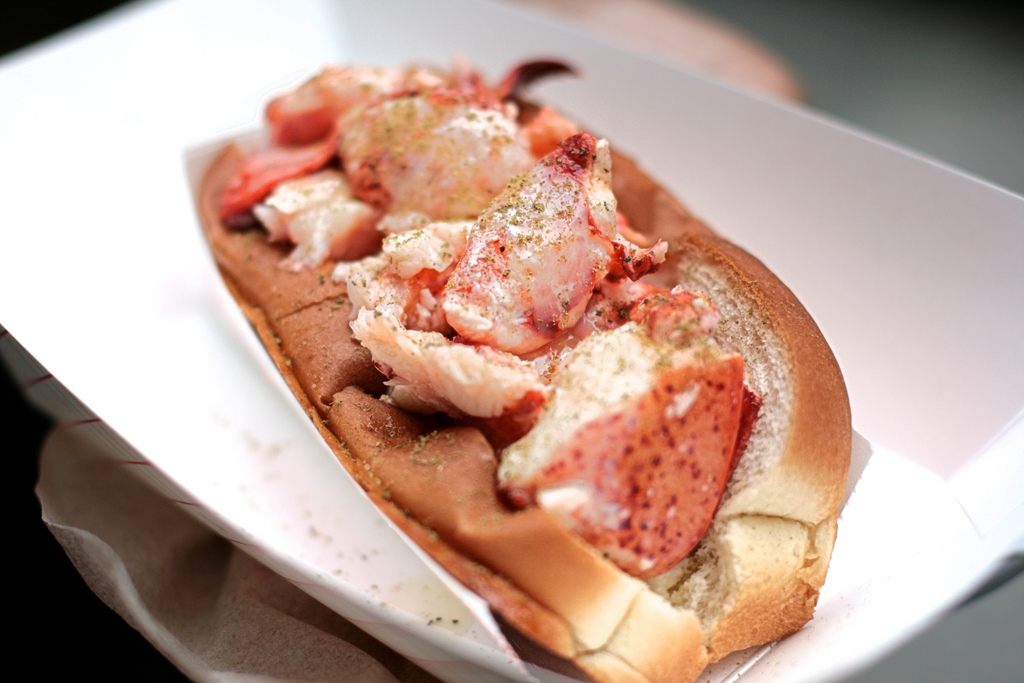How Millions of Pounds of Maine Lobster Make It From New York to China
 A lobster that made it to New York (Photo: New Amsterdam Market/Flickr)
A lobster that made it to New York (Photo: New Amsterdam Market/Flickr)
August is about the time for the lobster lovers of East Coast to start craving a good, buttery lobster roll. But, despite what Instagram might indicate, not every single person in the country’s most lobster-loving regions, stretching from the mid-Atlantic, up into New England, is actually vacationing in Maine.
It’s up to far-flung purveyors to keep the rest of us full of lobster: A popular spot can go through hundreds of lobster rolls a day, which requires a constant supply. The U.S. is also the largest live lobster market in the world and about 85 percent of America’s lobster haul comes from Maine. Last year, according to the state’s Department of Marine Resources, lobster fisherman brought in more than 120 million pounds of lobster.
Yet more Maine lobsters than ever are heading all the way to Asia—earlier this year, the Portland Press Herald reported that China was the top destination for Maine lobsters outside of North America. Hundreds of thousands of pounds leave each week for points far afield.
How, exactly, does that much lobster get from Maine, to anywhere else?
There are, of course, middlemen. Most lobster fisherman don’t sell directly to restaurants or consumers so dealers serve as middlemen, to individuals, restaurants, retail shops or processing plants. On the smaller end, dealers might ship personal orders of lobsters to individual customers. Someone throwing a party might place an order for as many as 50.
To ship live lobsters, dealers usually just pack the lobsters into a styrofoam box with gel packets to keep them cool. They do, sometimes, try to make the lobsters comfortable—one seller packs a little seaweed in, when it’s available. If there’re just a couple of lobster making the journey, they might spend the trip just chilling at the bottom of the box; a larger load of lobsters might get packed upright, to minimize the chances of damage en route.
On the more industrial end of the spectrum, a large distributor can go through tens of thousands of lobsters a day. At Inland Lobster, a division of one of the country’s largest fresh seafood distributors, lobsters are held in a large tank that can contain about 60,000 lobsters, according to Scout Wuerthner, a sales manager at the company.
Every day, about 20,000 pounds of live lobsters are shipped out to about 20 places, from Korea and China to Texas, Florida, and Georgia. If the lobster are traveling on an airplane, they’re packed in styrofoam boxes. If they’re traveling by refrigerated truck, they’ll be packed into simple wax corrugated boxes. The four to five thousand pounds of lobsters per day that Inland sends to distributors in New York, for instance, move by truck.
Some lobsters, though, end their lives in Maine, where they’re usually processed into fresh meat, of the sort that might fill a roll, or into frozen portions. Processors might cook the lobster, and pick the meat from the knuckles and claws. Some sell cooked tails as well; others freeze the tails raw. One processor, Shucks, manages to extract the meat from the shell without cooking it, by using pressurized water.
At Inland, they ship out lobster meat in 12 pound boxes, each containing the claws and knuckles of about 150 lobsters. (Those same lobsters will have produced 30 pounds worth of tails for the company.) All in all, says Wuerthner, the company handles about 9 million pounds of lobster a year.
 A lobster roll outside its native habitat (Photo: Alexis Lamster/Flickr)
A lobster roll outside its native habitat (Photo: Alexis Lamster/Flickr)
Buying from a big distributor isn’t the only option for restaurants that serve a large amount of lobster, though. Luke’s Lobster, a New York-based chain of lobster roll spots with 17 locations in New York, Philadelphia, D.C., Chicago, and Boston, has a “sister seafood company” which serves as its primary supplier. (The company sells fresh and frozen knuckle and claw meat, raw frozen tails, bodies, and roe, as well as frozen, ready-to-eat mince meat, as well as crab meat and claws.)
Another New York company, Homarus, promises local restaurants it can deliver lobster from Maine within 24 hours of the crustaceans having left the ocean. The company owns one truck that makes regular runs directly from New York to Maine, and receives lobsters from other trucks, as well, at its warehouse in Queens. In the morning, six vans go out to the city, to make delivers. A consistent, large restaurant order might be 200 to 400 pounds of lobster—a restaurant might order 100 pounds for Monday through Thursday, and 350 pounds for a weekend, says Brian McGovern, the co-founder of the company.
“Even in New York City, it’s been mind-blowing to me that some chefs have no idea that lobster is still a hunted product,” and not farm-raised, like shrimp, he says. “A lot of them really don’t understand what goes into getting that lobster to them.”
Gastro Obscura covers the world’s most wondrous food and drink.
Sign up for our regular newsletter.





























Follow us on Twitter to get the latest on the world's hidden wonders.
Like us on Facebook to get the latest on the world's hidden wonders.
Follow us on Twitter Like us on Facebook